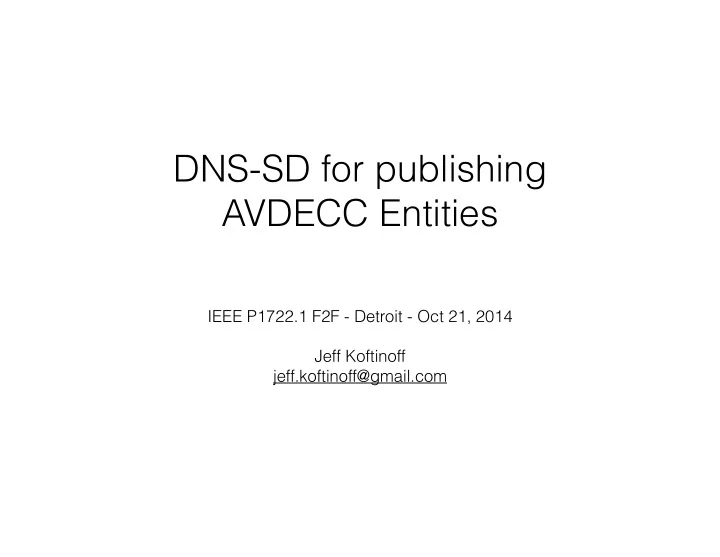

DNS-SD for publishing AVDECC Entities IEEE P1722.1 F2F - Detroit - Oct 21, 2014 Jeff Koftinoff jeff.koftinoff@gmail.com
Service Discovery • Service Discovery is a solved problem using the Domain Name System 2
IP transport of 1722 / 1722.1 • IEEE P1722 Draft 10 Annex J specifies how to transport AVTPDU’s via UDP • Enables transport of AVTP and AVDECC protocols via UDP on IPv4 and IPv6 networks • Destination UDP port 17220 is used for streams (“Continuous”) • Destination UDP port 17221 is used for control (“Discrete”) • UDP payload for both contains a 32 bit extended sequence number followed by the AVTPDU payload starting with the “subtype” field 3
DNS-SD • DNS Based Service Discovery (DNS-SD) is defined in RFC 6763 • DNS-SD is independent of Multicast DNS (MDNS) and does not require MDNS. • DNS-SD works with all DNS Servers • DNS-SD scales just as DNS does, across the Internet • DNS-SD allows services to be grouped together logically without regards to subnets. i.e. the subdomain “north.building.example.com.” can contain all of the entities on the north side of the building even if each floor uses a different subnet and subdomains. 4
Enabling DNS-SD service browsing on a DNS server • Add the “PTR” records to allow browsing services: b._dns-sd._udp.<domainname>. IN PTR <domainname>. lb._dns-sd._udp.<domainname>. IN PTR <domainname>. • See RFC6763 Section 11 for details and further options 5
Listing service types in a domain with DNS-SD • The “ _services._dns-sd._udp ” PTR records point to all of the services advertised in the domain. Each protocol type has a record for each service of that type. Example for the AVDECC UDP protocol: _services._dns-sd._udp.<domainname>. PTR _avdecc._udp.<domainname>. 6
Listing AVDECC services in a domain with DNS-SD • The “ _avdecc._udp ” PTR records point to the SRV (service) records representing the servers of that type in the domain. Example: _avdecc._udp.<domainname>. PTR mixer._avdecc._udp.<domainname>. _avdecc._udp.<domainname>. PTR stagebox1._avdecc._udp.<domainname>. _avdecc._udp.<domainname>. PTR stagebox2._avdecc._udp.<domainname>. 7
Listing AVDECC Service details in a domain with DNS-SD • Each “*. _avdecc._udp ” SRV record contains the priority, weight, UDP port, and host name for a specific AVDECC Service. Example: mixer._avdecc._udp.<domainname>. SRV 0 0 17221 mixer.<domainname>. stagebox1._avdecc._udp.<domainname>. SRV 0 0 17221 stagebox1.<domainname>. stagebox2._avdecc._udp.<domainname>. SRV 0 0 17221 stagebox2.<domainname>. • Each “*. _avdecc._udp ” SRV record is required to also have an associated TXT record. Example: mixer._avdecc._udp.<domainname>. TXT “txtvers=1” stagebox1._avdecc._udp.<domainname>. TXT “txtvers=1” stagebox2._avdecc._udp.<domainname>. TXT “txtvers=1” 8
Listing AVDECC Service Host Names in a domain with DNS-SD • Each A record contains an IPv4 address of a service. Each AAAA record contains an IPv6 address of a service. A single service may be accessible via multiple IPv4 and IPv6 addresses. Example: stagebox1.<domainname>. A 192.168.147.5 stagebox1.<domainname>. A 192.168.147.6 mixer.<domainname>. A 192.168.147.7 mixer.<domainname>. AAAA fe80::3e15:c2ff:fee7:3a0 mixer.<domainname>. AAAA fd57:2bb3:a4bf:d6af:79ba:23b5:ffa5:4ecc 9
Looking up AVDECC Entities with DNS-SD • Once the DNS records are in place, you can find the details of all the AVDECC Entities in a (sub)domain. On Mac OS X: $ dns-sd -B _avdecc._udp <domainname>. … Timestamp A/R Flags if Domain Service Type Instance Name 5:27:08.098 Add 3 4 <domainname>. _avdecc._udp. mixer 5:27:08.098 Add 3 4 <domainname>. _avdecc._udp. stagebox1 5:27:08.098 Add 2 4 <domainname>. _avdecc._udp. stagebox2 $ dns-sd -L mixer _avdecc._udp <domainname>. Lookup mixer._avdecc._udp.<domainname>. 5:27:14.404 mixer._avdecc._udp.<domainname>. … at mixer.<domainname>.:17221 Flags: 2 txtvers=1 • On Linux with avahi ( see www.avahi.org ) $ avahi-browse -d <domainname>. -r _avdecc._udp 10
Details of the AVDECC DNS-SD lookup • Using the ubiquitous “nslookup” tool do an actual query for PTR records at “_avdecc._udp.statusbar.info.” and each returned record points to one SRV record and a TXT record, and follow the SRV for the connection info (actual console log): $ nslookup -query=PTR _avdecc._udp.statusbar.info. _avdecc._udp.statusbar.info name = mixer._avdecc._udp.statusbar.info. _avdecc._udp.statusbar.info name = stagebox1._avdecc._udp.statusbar.info. _avdecc._udp.statusbar.info name = stagebox2._avdecc._udp.statusbar.info. $ nslookup -query=SRV mixer._avdecc._udp.statusbar.info. mixer._avdecc._udp.statusbar.info service = 0 0 17221 mixer.statusbar.info. $ nslookup -query=TXT mixer._avdecc._udp.statusbar.info. mixer._avdecc._udp.statusbar.info text = "txtvers=1" $ nslookup -query=A mixer.statusbar.info. Address: 192.168.147.7 11
Enumeration • At this point, the Controller knows to send AECP AEM GET_DESCRIPTOR commands to 192.168.147.7 UDP port 17221 to enumerate the mixer entity • The Controller repeats this process with the other Talkers and Listeners in the domain 12
Creating the DNS-SD Records • The DNS-SD records can be created by the IT administrator for the domain using the normal DNS tools • Another option is for the Entities to be configured to use RFC2845 to do secure remote updates of DNS records of the DNS servers. • All of this functionality is also compatible with Multicast DNS (aka Bonjour, RFC 6762) and “Wide Area Bonjour” • A good reference on DNS-SD is Stuart Cheshire’s book: “Zero Configuration Networking: The Definitive Guide,” ISBN: 978-0-596-10100-8 13
Publishing Streams with DNS-SD • While it is definitely possible to publish “_avtp._udp.” services via DNS-SD, with properties in the TXT records, it is not desirable since: • Stream properties and availability can change dynamically and DNS records have long TTL in order to reduce pressure • The typically very large number of streams adds pressure on the DNS server due to the multitude of PTR, SRV, TXT and A records • DNS TXT records for stream properties is duplication of some AVDECC functionality yet insufficient to fully replace AVDECC enumeration, configuration, stream management and diagnostics. • An AVDECC Controller does this better. 14
Recommend
More recommend